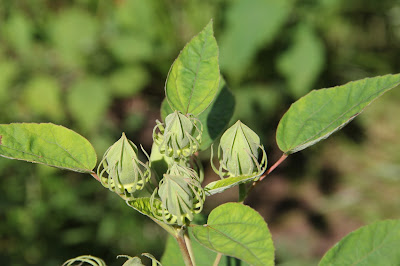One of the most enjoyable aspects of Hoot Owl Karma is enhancing my own knowledge of our natural world. Every walk to the mailbox, every payroll delivery run and every trip to the grocery store, not to mention nature hikes and trips to the coast and mountains, is an opportunity to learn something new about our natural environment. Hoot Owl Karma has helped me hone my senses and "tune in" more effectively to the world of nature that surrounds us.
One of the first questions I typically ask upon encountering a new plant or animal, or taking a closer look at familiar ones, is whether it is "native" or "alien." Perhaps it doesn't really matter, but I must confess that I invariably feel a twinge of regret when I determine that an otherwise appealing subject is an "alien;" as though it were now somehow less worthy of appreciation or further study.
For the past month or so, I have noticed the plants I call marshmallows, or wild hibiscus, blooming throughout our area. These plants look very similar to the cultivated hibiscus so popular with gardeners and landscapers, and there was once a time when I dismissed the "wild" hibiscus as mere naturalized escapees from our southern gardens, most likely native to the tropics.
Yesterday I finally took a moment to photograph a group growing in the wet but sunny intersection of a wastewater easement and a utility line easement along my daily route to the post office. Much of the area had fallen into shadow, and many of the blossoms were closed, but I snapped a few shots anyway.
Upon closer inspection, the flowers and buds and leaves so closely resembled the garden hibiscus, that I began to wonder if someone had planted these here along the power lines as part of a beautification project.
When I returned home after work and attempted to identify my wild hibiscus to species, I was intrigued to find that the ubiquitous marshmallow or wild hibiscus is not, nor was it ever an introduced garden plant. On the contrary, most of the popular cultivated hibiscus varieties in our region were originally one of the wild hibiscus species. There are several species of wild hibiscus native to the southeastern U.S., all of which have been cultivated and selectively bred for decades to produce the hibiscus varieties so popular in our southern gardens.
The resemblance between wild and domestic is remarkable, as evidenced by these cultivated plants with huge red "dinner plate" blossoms planted in front of the high school where Julie teaches and the boys attend. We'll spend some more time with this notion of "native" and what it means in the broader context of conservation in future posts.
But for now, we're going to read a bit more about the native hibiscus of the southeast and try to bring you a specific identification for both the wild and domestic hibiscus featured in this post. Until then, perhaps you can enjoy them simply as beautiful flowers.







No comments:
Post a Comment